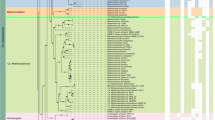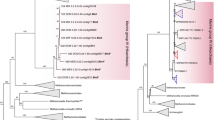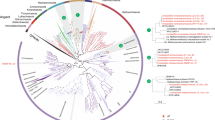Abstract
Methanogenic archaea are major players in the global carbon cycle and in the biotechnology of anaerobic digestion. The phylum Euryarchaeota includes diverse groups of methanogens that are interspersed with non-methanogenic lineages. So far, methanogens inhabiting hypersaline environments have been identified only within the order Methanosarcinales. We report the discovery of a deep phylogenetic lineage of extremophilic methanogens in hypersaline lakes and present analysis of two nearly complete genomes from this group. Within the phylum Euryarchaeota, these isolates form a separate, class-level lineage ‘Methanonatronarchaeia’ that is most closely related to the class Halobacteria. Similar to the Halobacteria, ‘Methanonatronarchaeia’ are extremely halophilic and do not accumulate organic osmoprotectants. The high intracellular concentration of potassium implies that ‘Methanonatronarchaeia’ employ the ‘salt-in’ osmoprotection strategy. These methanogens are heterotrophic methyl-reducers that use C1-methylated compounds as electron acceptors and formate or hydrogen as electron donors. The genomes contain an incomplete and apparently inactivated set of genes encoding the upper branch of methyl group oxidation to CO2 as well as membrane-bound heterodisulfide reductase and cytochromes. These features differentiate ‘Methanonatronarchaeia’ from all known methyl-reducing methanogens. The discovery of extremely halophilic, methyl-reducing methanogens related to haloarchaea provides insights into the origin of methanogenesis and shows that the strategies employed by methanogens to thrive in salt-saturating conditions are not limited to the classical methylotrophic pathway.
This is a preview of subscription content, access via your institution
Access options
Access Nature and 54 other Nature Portfolio journals
Get Nature+, our best-value online-access subscription
$29.99 / 30 days
cancel any time
Subscribe to this journal
Receive 12 digital issues and online access to articles
$119.00 per year
only $9.92 per issue
Buy this article
- Purchase on Springer Link
- Instant access to full article PDF
Prices may be subject to local taxes which are calculated during checkout






Similar content being viewed by others
References
Ferry, J. G. & Kastead, K. A. in Archaea: Molecular and Cellular Biology (ed. Cavicchioli, R. ) 288–214 (ASM, 2007).
Conrad, R. The global methane cycle: recent advances in understanding the microbial processes involved. Environ. Microbiol. Rep. 1, 285–292 (2009).
Inventory of US Greenhouse Gas Emissions and Sinks: 1990–2014. (US EPA, 2016).
Garrity, G. M. & Holt, J. G. in Bergey's Manual of Systematics of Archaea and Bacteria Vol. 1 http://doi.org/10.1002/9781118960608.pbm00014 (Wiley, 2015).
Iino, T. et al. Candidatus Methanogranum caenicola: a novel methanogen from the anaerobic digested sludge, and proposal of Methanomassiliicoccaceae fam. nov. and Methanomassiliicoccales ord. nov., for a methanogenic lineage of the class Thermoplasmata. Microbes Environ. 28, 244–250 (2013).
Borrel, G. et al. Comparative genomics highlights the unique biology of Methanomassiliicoccales, a Thermoplasmatales-related seventh order of methanogenic archaea that encodes pyrrolysine. BMC Genomics 15, 679 (2014).
Lang, K. et al. New mode of energy metabolism in the seventh order of methanogens as revealed by comparative genome analysis of ‘Candidatus Methanoplasma termitum’. Appl. Environ. Microbiol. 81, 1338–1352 (2015).
Evans, P. N. et al. Methane metabolism in the archaeal phylum Bathyarchaeota revealed by genome-centric metagenomics. Science 350, 434–438 (2015).
Vanwonterghem, I. et al. Methylotrophic methanogenesis discovered in the archaeal phylum Verstraetearchaeota. Nat. Microbiol. 1, 16170 (2016).
Hedderich, R. & Whitman, W. B. in The Prokaryotes—Prokaryotic Physiology and Biochemistry (ed. Rosenberg, E. ) 636–663 (Springer, 2013).
Liu, Y. & Whitman, W. B. Metabolic, phylogenetic, and ecological diversity of the methanogenic archaea. Ann. NY Acad. Sci. 1125, 171–189 (2008).
Thauer, R. K., Kaster, A. K., Seedorf, H., Buckel, W. & Hedderich, R. Methanogenic archaea: ecologically relevant differences in energy conservation. Nat. Rev. Microbiol. 6, 579–591 (2008).
Borrel, G. et al. Phylogenomic data support a seventh order of methylotrophic methanogens and provide insights into the evolution of methanogenesis. Genome Biol. Evol. 5, 1769–1780 (2013).
Dridi, B., Fardeau, M. L., Ollivier, B., Raoult, D. & Drancourt, M. Methanomassiliicoccus luminyensis gen. nov., sp. nov., a methanogenic archaeon isolated from human faeces. Int. J. Syst. Evol. Microbiol. 62, 1902–1907 (2012).
Paul, K., Nonoh, J. O., Mikulski, L. & Brune, A. ‘Methanoplasmatales,’ Thermoplasmatales-related archaea in termite guts and other environments, are the seventh order of methanogens. Appl. Environ. Microbiol. 78, 8245–8253 (2012).
Fricke, W. F. et al. The genome sequence of Methanosphaera stadtmanae reveals why this human intestinal archaeon is restricted to methanol and H2 for methane formation and ATP synthesis. J. Bacteriol. 188, 642–658 (2006).
Miller, T. L. & Wolin, M. J. Methanosphaera stadtmaniae gen. nov., sp. nov.: a species that forms methane by reducing methanol with hydrogen. Arch. Microbiol. 141, 116–122 (1985).
Sprenger, W. W., Hackstein, J. H. & Keltjens, J. T. The energy metabolism of Methanomicrococcus blatticola: physiological and biochemical aspects. Antonie van Leeuwenhoek 87, 289–299 (2005).
Sprenger, W. W., Hackstein, J. H. & Keltjens, J. T. The competitive success of Methanomicrococcus blatticola, a dominant methylotrophic methanogen in the cockroach hindgut, is supported by high substrate affinities and favorable thermodynamics. FEMS Microbiol. Ecol. 60, 266–275 (2007).
Sprenger, W. W., van Belzen, M. C., Rosenberg, J., Hackstein, J. H. & Keltjens, J. T. Methanomicrococcus blatticola gen. nov., sp. nov., a methanol- and methylamine-reducing methanogen from the hindgut of the cockroach Periplaneta americana. Int. J. Syst. Evol. Microbiol. 50, 1989–1999 (2000).
Nobu, M. K., Narihiro, T., Kuroda, K., Mei, R. & Liu, W. T. Chasing the elusive Euryarchaeota class WSA2: genomes reveal a uniquely fastidious methyl-reducing methanogen. ISME J. 10, 2478–2487 (2016).
Borrel, G., Adam, P. S. & Gribaldo, S. Methanogenesis and the Wood–Ljungdahl pathway: an ancient, versatile, and fragile association. Genome Biol. Evol. 8, 1706–1711 (2016).
McGenity, T. J. in Handbook of Hydrocarbon and Lipid Microbiology (ed. Timmis, K. N. ) 665–679 (Springer, 2010).
Kelley, C. A., Poole, J. A., Tazaz, A. M., Chanton, J. P. & Bebout, B. M. Substrate limitation for methanogenesis in hypersaline environments. Astrobiology 12, 89–97 (2012).
Oremland, R. S. & King, G. M. in Microbial Mats. Physiological Ecology of Benthic Microbial Communities (eds Cohen, Y. & Rosenberg, E. ) 180–190 (American Society for Microbiology, 1989).
Martin, D. D., Ciulla, R. A. & Roberts, M. F. Osmoadaptation in archaea. Appl. Environ. Microbiol. 65, 1815–1825 (1999).
Menaia, J. A. G. F. Osmotics of Halophilic Methanogenic Archaeobacteria. PhD thesis, Oregon Health Sci Univ. (1992).
Sorokin, D. Y . et al. Methanogenesis at extremely haloalkaline conditions in the soda lakes of Kulunda Steppe (Altai, Russia). FEMS Microbiol. Ecol. 91, pii: fiv016 (2015).
Ginzburg, M., Sachs, L. & Ginzburg, B. Z. Ion metabolism in a Halobacterium. I. Influence of age of culture on intracellular concentrations. J. Gen. Physiol. 55, 187–207 (1970).
Elevi Bardavid, R. & Oren, A. The amino acid composition of proteins from anaerobic halophilic bacteria of the order Halanaerobiales. Extremophiles 16, 567–572 (2012).
Oren, A. Life at high salt concentrations, intracellular KCl concentrations, and acidic proteomes. Front. Microbiol. 4, 315 (2013).
Sorokin, D. Y., Banciu, H. L. & Muyzer, G. Functional microbiology of soda lakes. Curr. Opin. Microbiol. 25, 88–96 (2015).
Abken, H. J. et al. Isolation and characterization of methanophenazine and function of phenazines in membrane-bound electron transport of Methanosarcina mazei Go1. J. Bacteriol. 180, 2027–2032 (1998).
Makarova, K. S., Wolf, Y. I. & Koonin, E. V. Archaeal clusters of orthologous genes (arCOGs): an update and application for analysis of shared features between Thermococcales, Methanococcales, and Methanobacteriales. Life (Basel) 5, 818–840 (2015).
Yutin, N., Puigbo, P., Koonin, E. V. & Wolf, Y. I. Phylogenomics of prokaryotic ribosomal proteins. PLoS ONE 7, e36972 (2012).
Eder, W., Schmidt, M., Koch, M., Garbe-Schonberg, D. & Huber, R. Prokaryotic phylogenetic diversity and corresponding geochemical data of the brine–seawater interface of the Shaban Deep, Red Sea. Environ. Microbiol. 4, 758–763 (2002).
Jiang, H. et al. Microbial response to salinity change in Lake Chaka, a hypersaline lake on Tibetan plateau. Environ. Microbiol. 9, 2603–2621 (2007).
Yarza, P. et al. Uniting the classification of cultured and uncultured bacteria and archaea using 16S rRNA gene sequences. Nat. Rev. Microbiol. 12, 635–645 (2014).
Wolf, Y. I., Makarova, K. S., Yutin, N. & Koonin, E. V. Updated clusters of orthologous genes for Archaea: a complex ancestor of the Archaea and the byways of horizontal gene transfer. Biol. Direct 7, 46 (2012).
Makarova, K. S., Koonin, E. V. & Albers, S. V. Diversity and evolution of type IV pili systems in archaea. Front. Microbiol. 7, 667 (2016).
Zheng, K., Ngo, P. D., Owens, V. L., Yang, X. P. & Mansoorabadi, S. O. The biosynthetic pathway of coenzyme F430 in methanogenic and methanotrophic archaea. Science 354, 339–342 (2016).
Aono, R. et al. Enzymatic characterization of AMP phosphorylase and ribose-1,5-bisphosphate isomerase functioning in an archaeal AMP metabolic pathway. J. Bacteriol. 194, 6847–6855 (2012).
Baines, A. J. Evolution of spectrin function in cytoskeletal and membrane networks. Biochem. Soc. Trans. 37, 796–803 (2009).
Hallam, S. J., Girguis, P. R., Preston, C. M., Richardson, P. M. & DeLong, E. F. Identification of methyl coenzyme M reductase A (mcrA) genes associated with methane-oxidizing archaea. Appl. Environ. Microbiol. 69, 5483–5491 (2003).
Sorokin, D. Y. et al. Methanosalsum natronophilum sp. nov., and Methanocalculus alkaliphilus sp. nov., haloalkaliphilic methanogens from hypersaline soda lakes. Int. J. Syst. Evol. Microbiol. 65, 3739–3745 (2015).
Pfennig, N. & Lippert, K. D. Über das vitamin B12-Bedürfnis phototropher schwefelbakterien. Arch. Mikrobiol. 55, 245–256 (1966).
Plugge, C. M. Anoxic media design, preparation, and considerations. Meth. Enzymol. 397, 3–16 (2005).
Podar, M. et al. Insights into archaeal evolution and symbiosis from the genomes of a nanoarchaeon and its inferred crenarchaeal host from obsidian pool, Yellowstone national park. Biol. Direct 8, 9 (2013).
Seemann, T. Prokka: rapid prokaryotic genome annotation. Bioinformatics 30, 2068–2069 (2014).
Besemer, J., Lomsadze, A. & Borodovsky, M. GeneMarkS: a self-training method for prediction of gene starts in microbial genomes. Implications for finding sequence motifs in regulatory regions. Nucleic Acids Res. 29, 2607–2618 (2001).
Altschul, S. F. et al. Gapped BLAST and PSI-BLAST: a new generation of protein database search programs. Nucleic Acids Res. 25, 3389–3402 (1997).
Soding, J., Biegert, A. & Lupas, A. N. The HHpred interactive server for protein homology detection and structure prediction. Nucleic Acids Res. 33, W244–W248 (2005).
Edgar, R. C. MUSCLE: multiple sequence alignment with high accuracy and high throughput. Nucleic Acids Res. 32, 1792–1797 (2004).
Price, M. N., Dehal, P. S. & Arkin, A. P. Fasttree 2—approximately maximum-likelihood trees for large alignments. PLoS ONE 5, e9490 (2010).
Guindon, S. et al. New algorithms and methods to estimate maximum-likelihood phylogenies: assessing the performance of PhyML 3.0. Syst. Biol. 59, 307–321 (2010).
Darriba, D., Taboada, G. L., Doallo, R. & Posada, D. Prottest 3: fast selection of best-fit models of protein evolution. Bioinformatics 27, 1164–1165 (2011).
Bjellqvist, B. et al. The focusing positions of polypeptides in immobilized pH gradients can be predicted from their amino acid sequences. Electrophoresis 14, 1023–1031 (1993).
Rice, P., Longden, I. & Bleasby, A. EMBOSS: the European Molecular Biology Open Software Suite. Trends Genet. 16, 276–277 (2000).
Parzen, E. On estimation of a probability density function and mode. Ann. Math. Statist. 33, 1065–1076 (1962).
Kullback, S. & Leibler, R. A. On information and sufficiency. Ann. Math. Stat. 22, 79–86 (1951).
Gower, J. C. Some distance properties of latent root and vector methods used in multivariate analysis. Biometrika 53, 325–338 (1966).
Torgeson, W. S. Theory and Methods of Scaling (Wiley, 1958).
R (R Foundation for Statistical Computing, 2013).
Gupta, N. & Pevzner, P. A. False discovery rates of protein identifications: a strike against the two-peptide rule. J. Proteome Res. 8, 4173–4181 (2009).
Acknowledgements
D.Y.S. was supported by STW (project no. 12226), the Gravitation-SIAM Program (grant no. 24002002 from the Dutch Ministry of Education and Science) and by RFBR (grant no. 16-04-00035). K.S.M., Y.I.W. and E.V.K. are supported by the intramural programme of the US Department of Health and Human Services (to the National Library of Medicine). The proteomic analysis was performed in the Proteomics Facility of The Spanish National Center for Biotechnology (CNB-CSIC), which belongs to ProteoRed (PRB2-ISCIII), supported by grant no. PT13/0001. This project received funding from the European Union's Horizon 2020 research and innovation programme (Blue Growth: Unlocking the potential of Seas and Oceans) under grant agreement no. 634486. This work was further funded by grant no. BIO2014-54494-R from the Spanish Ministry of Economy, Industry and Competitiveness.
Author information
Authors and Affiliations
Contributions
D.Y.S. performed the fieldwork, the sediment activity incubations, enrichment and isolation of pure cultures and microbiological investigation of enriched and pure cultures. B.A. and A.Y.M. analysed the mcrA and 16S rRNA genes in sediments and methanogenic cultures. M.F., P.N.G., S.C. and M.C.M.v.L. were responsible for the proteomic analysis. E.A.G. analysed compatible solutes. K.S.M., Y.I.W. and E.V.K. performed genomic analysis and evolutionary reconstructions. D.Y.S., K.S.M. and E.V.K. wrote the paper. M.C.M.v.L. oversaw the project and participated in the data interpretation and discussion.
Corresponding authors
Ethics declarations
Competing interests
The authors declare no competing financial interests.
Supplementary information
Supplementary information
Supplementary Figures 1–10; Supplementary Tables 1 and 2; Supplementary Data 1–4. (PDF 17605 kb)
Supplementary Table 3
Comparative genomic analysis based on arCOG assignments. (XLSX 6009 kb)
Supplementary Table 4
Reconstruction of gene gain and loss. (XLSX 434 kb)
Supplementary Table 5
Isoelectric point calculation data. (XLSX 25 kb)
Supplementary Table 6
Proteomic analysis for AMET1. (XLSX 121 kb)
Supplementary Table 7
Proteomic analysis for HMET1. (XLSX 179 kb)
Rights and permissions
About this article
Cite this article
Sorokin, D., Makarova, K., Abbas, B. et al. Discovery of extremely halophilic, methyl-reducing euryarchaea provides insights into the evolutionary origin of methanogenesis. Nat Microbiol 2, 17081 (2017). https://doi.org/10.1038/nmicrobiol.2017.81
Received:
Accepted:
Published:
DOI: https://doi.org/10.1038/nmicrobiol.2017.81
This article is cited by
-
Unraveling the phylogenomic diversity of Methanomassiliicoccales and implications for mitigating ruminant methane emissions
Genome Biology (2024)
-
Expanded phylogeny of extremely halophilic archaea shows multiple independent adaptations to hypersaline environments
Nature Microbiology (2024)
-
A compendium of viruses from methanogenic archaea reveals their diversity and adaptations to the gut environment
Nature Microbiology (2023)
-
Diversity and function of methyl-coenzyme M reductase-encoding archaea in Yellowstone hot springs revealed by metagenomics and mesocosm experiments
ISME Communications (2023)
-
Extremophiles: the species that evolve and survive under hostile conditions
3 Biotech (2023)



